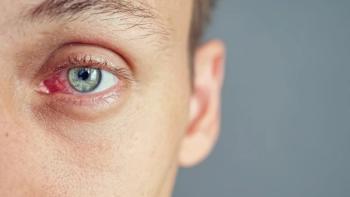
- May digital edition 2021
- Volume 13
- Issue 5
Using surveys to help manage dry eye disease
Patient questionnaires differ in length, focus, and validity
In my practice, I find patients will often fail to report concerns related to dry eye or lid disease when asked open-ended questions by my technical staff. As I examined my patients prior to the novel COVID-19 pandemic, I would ask questions about symptomatology based upon clinical signs while performing biomicroscopy. But now I try to balance my examination with avoiding breathing 6 inches from someone’s face and fogging my oculars. I have found that using a questionnaire helps to facilitate this discussion, allowing me to address the signs and symptoms from across the room.
Quantification and tracking of patients’ symptoms are important to clinical care. This is especially true regarding patients with dry eye, where much of the decision-making process is based on symptoms instead of clinical signs, as is the case with glaucoma or keratoconus. Many questionnaires are available to use to determine patient-reported outcomes for therapeutic efficacy. They differ regarding the year created, language used, number of questions, question content, and degree of validation.1 Such assessments lend insight when patients visit an OD’s office for help with their visual comfort. I will review these questionnaires here and attempt to lend insight into which are better to use in clinic.
National Eye Institute Visual Function Questionnaire (NEI-VFQ-25)
I included this survey because it is often used to compare and validate dry eye disease (DED) questionnaires. The original survey developed in 2001 included 51 questions, and a shorter instrument of just 25 questions is often used.2
This survey is often used in research and has been validated in 50 languages. It boasts strong validity, internal consistency, and test-retest reliability. It correlates well with the Ocular Surface Disease Index (OSDI), less so with the McMonnies questionnaire. NEI-VFQ-25 contains pain subscales that are sometimes used in studies but are not specific for DED or the psychometric properties of DED.1
OSDI
The OSDI has been used extensively in research. It is a 12-item survey developed in 1997.3 It boasts strong psychometric properties and was created to assess subjective dry eye symptoms and their effects on vision-related activities of daily living over the previous week.1
It contains 3 questions regarding ocular symptoms and environmental triggers and 6 questions regarding vision-related function.
It is available in many languages. However, it does not address all dry eye symptoms, such as foreign body sensation. It has been compared with many of the questionnaires discussed here. The following questionnaires have strong psychometric properties addressing health-related quality of life (QOL).
Dry Eye-Related Quality-of-Life Score (DEQS)
The DEQS questionnaire is a 15-item survey developed in 2013 to assess subjective symptoms and DED effects on daily living activities over the previous week.4 It includes 6 questions on ocular symptoms and 9 on DED effects on QOL. The test scores significantly correlate with the NEI-VFQ-25. However, it has been validated only in Japanese.
Impact of Dry Eye in Everyday Life (IDEEL)
The IDEEL questionnaire is a 57-item diagnostic instrument with strong psychometric properties developed in 2003.5 Its questions assess subjective dry eye symptoms and satisfaction with DED treatment within the previous 2 weeks as well as vision-related functions of daily living.1
It is available in English and Chinese and is based on FDA guidance on patient-reported outcomes, but it must be purchased and takes 30 minutes to complete. The OSDI and the IDEEL are both strongly validated and reliable DED questionnaires to assess QOL.6
University of North Carolina Dry Eye Management Scale (UNC DEMS)
The UNC DEMS is a single-item questionnaire developed in 2014 to assess subjective symptoms and their effects on daily living activities over the previous week.7 It boasts strong psychometric properties and was developed based on the FDA’s Patient Reported Outcomes guidance.
It is available in English but has not been validated in other languages. It is strongly correlated with the OSDI and moderately correlated with tear film break-up time (TFBUT).7
Ocular Comfort Index (OCI)
The OCI is a 12-item questionnaire developed in 2007 to evaluate ocular symptoms within the previous week.8 This survey has good psychometric properties but asks questions only about ocular symptoms. It does not ask questions about health-related QOL. It has a moderate positive correlation with the OSDI and negative correlation with TFBUT. The next group of questionnaires are less sound psychometrically.
Dry Eye Questionnaire (DEQ)
The DEQ was developed in 2001 and contains 21 questions for DED diagnosis and severity assessment. 9 Despite being developed to assess DED effect on QOL, it lacks a designated cutoff value to clinical application. It has not been validated in languages other than English. Although the DEQ correlated significantly with the OSDI and McMonnies questionnaires, its reliability has not been vetted.1
The DEQ was shortened to create the DEQ-5 (Figure 1). This survey includes questions about the frequency and severity of ocular discomfort and dryness over the last month and includes a question about frequency of watery eyes.
Ocular Surface Disease (OSD)
The OSD is an 80-item questionnaire that was first reported in 2002.10 The French group behind the survey wanted to create a patient self-evaluation questionnaire specific to OSD. Four sections address patient symptoms, medical history, satisfaction with treatment, and OSD QOL over an indefinite time frame.
The English version of the OSD QOF section was created in 2015.1 This OSD section is not specific for DED and lacks a designated cutoff value, but psychometric properties have been examined. The OSD QOF section was reported to have good validity and reliability, although the overall questionnaire has not been vetted.1
Contact Lens Dry Eye Questionnaire (CLDEQ)
The CLDEQ contains 36 questions and was developed in 2001.11 It was created to specifically investigate dry eye symptoms among contact lens wearers. Its psychometric properties have not been vetted. It addresses QOL concerns in contact lens wearers over the last 7 days, but it does not have a designated cutoff value for DED. A shorter version of 8 questions was developed in 2012,12 but testing was limited to small sample groups.
Standard Patient Evaluation of Eye Dryness Questionnaire (SPEED)
The SPEED is a 20-item survey developed in 2005 to assess the severity and subjective symptoms of patients with DED.13 Its psychometric properties have not been fully investigated.
The questionnaire obtains subjective responses about the presence or absence, frequency, and severity of dry eye symptoms. It does not have adesignated cutoff value.
There is a good correlation between the SPEED and the meibomian gland function, one of the main DED causes. Therefore, this questionnaire is useful for meibomian gland dysfunction evaluation.14,15
Symptom Assessment in Dry Eye (SANDE) The SANDE survey is a 2-item instrument developed in 2007 to quantify the frequency of dry eye symptoms and severity over the previous 60 days.16 Its psychometric properties have not been adequately examined. The questionnaire has 2 versions. Initial testing uses version 1. The patient is instructed to indicate on a horizontal scale their severity of symptoms. Repeat testing is performed using version 2.
Patients indicate the change in frequency and severity using a similar horizontal scale with their status at last visit designated at the midline. There is no designated cutoff value. Despite the simplicity of the test, baseline SANDE and OSDI scores were significantly correlated at the baseline visit. Changes in the SANDE and OSDI score from baseline to follow-up visits were significantly correlated as well, although less so. Examinations of reliability have not been performed.
Commentary
The NEI-VFQ-25 and the OSDI surveys are often used in research, so it is important for ODs to be familiar with these instruments. The Dry Eye Workshop II (DEWS II) recommended the OSDI and the DEQ-5.17
The OSDI is available as an iPhone application (Figure 2). The cutoff values for mild, moderate, and severe dry eye assist practitioners with treatment decisions.
For contact lens practitioners, a contact lens-specific questionnaire can be useful to identify concerns related to wearing time and comfort. Contact lens wearers may not have the standard dry eye symptoms identified using other questionnaires.
Personally, I have used the SPEED questionnaire in my office for years. It is quick to administer, which I appreciate, and it is useful in quantifying the severity of the most common dry eye symptoms experienced by patients.18,19 Other tests may be stronger psychometrically, or address QOL, but in my practice I am concerned primarily with ocular symptoms.
References
1. Okumura Y, Inomata T, Iwata N, et al. A review of dry eye questionnaires: measuring patient-reported outcomes and health-related quality of life. Diagnostics (Basel). 2020;10(8):559. doi:10.3390/diagnostics10080559
2. Mangione CM, Lee PP, Gutierrez PR, Spritzer K, Berry S, Hays RD; National Eye Institute Visual Function Questionnaire Field Test Investigators. Development of the 25-listitem national eye institute visual function questionnaire. Arch Ophthalmol. 2001;119(7):1050-1058. doi:10.1001/ archopht.119.7.1050
3. Walt J, Rowe M, Stern K. Evaluating the functional impact of dry eye: the Ocular Surface Disease Index. Drug Inf J. 1997;31:1436.
4. Sakane Y, Yamaguchi M, Yokoi N, et al. Development and validation of the dry eye–related quality-of-life score questionnaire. JAMA Ophthalmol. 2013;131(10):1331-1338. doi:10.1001/jamaophthalmol.2013.4503
5. Abetz L, Venkataraman K, Mertzanis P, Chalmers R, Begley C. The development, reliability and validity of a questionnaire to assess the impact of dry eyes on everyday life (IDEEL). Invest Ophthalmol Vis Sci. 2003;44(13):2477.
6. Grubbs JR Jr, Tolleson-Rinehart S, Huynh K, Davis RM. A review of quality of life measures in dry eye questionnaires. Cornea. 2014;33(2):215-218. doi:10.1097/ ICO.0000000000000038
7. Grubbs Jr J, Huynh K, Tolleson-Rinehart S, et al. Instrument development of the UNC dry eye management scale. Cornea. 2014;33(11):1186-1192. doi:10.1097/ ICO.0000000000000243
8. Johnson ME, Murphy PJ. Measurement of ocular surface irritation on a linear interval scale with the ocular comfort index. Invest Ophthalmol Vis Sci. 2007;48(10):4451-4458. doi: 10.1167/iovs.06-1253
9. Begley CG, Chalmers RL, Mitchell GL, et al. Characterization of ocular surface symptoms from optometric practices in North America. Cornea. 2001;20(6):610-618. doi:10.1097/00003226-200108000-00011
10. Baudouin C, Creuzot-Garcher C, Hoang-Xuan T, et al. [Creating a specific diagnostic and quality-of-life questionnaire for patients with ocular surface disease]. J Fr Ophtalmol. 2003;26(2):119-130.
11. Nichols JJ, Mitchell GL, Nichols KK, Chalmers R, Begley C. The performance of the contact lens dry eye questionnaire as a screening survey for contact lens-related dry eye. Cornea. 2002;21(5):469-475. doi:10.1097/00003226-200207000- 00007
12. Chalmers RL, Begley CG, Moody K, Hickson- Curran SB. Contact lens dry eye questionnaire-8 (CLDEQ-8) and opinion of contact lens performance. Optom Vis Sci. 2012;89(10):1435-1442. doi:10.1097/ OPX.0b013e318269c90d
13. Korb DR, Scaffidi RC, Greiner JV, Scaffidi RC, Greiner JV, et al. The effect of two novel lubricant eye drops on tear film lipid layer thickness in subjects with dry eye symptoms. Optom Visi Sci. 2005;82(7):594-601. doi:10.1097/01. opx.0000171818.01353.8c
14. Rong B, Tang Y, Tu P, et al. Intense pulsed light applied directly on eyelids combined with meibomian gland expression to treat meibomian gland dysfunction. Photomed Laser Surg. 2018;36(6):326-332. doi:10.1089/pho.2017.4402
15. Arita R, Fukuoka S, Morishige N. Therapeutic efficacy of intense pulsed light in patients with refractory meibomian gland dysfunction. Ocul Surf. 2019;17(1):104-110. doi:10.1016/j.jtos.2018.11.004
16. Schaumberg DA, Gulati A, Mathers WD, et al. Development and validation of a short global dry eye symptom index. Ocul Surf. 2007;5(1):50-57. doi:10.1016/s1542-0124(12)70053-8
17. Wolffsohn JS, Arita R, Chalmers R, Djalilian A, Dogru M, Dumbleton K, et al. TFOS DEWS II diagnostic methodology report. Ocul Surf. 2017;15(3):539-574. doi:10.1016/j. jtos.2017.05.001
18. Korb DR, Benjamin WJ, Nau A. Meibomian gland structure is correlated to meibomian gland function. Invest Ophthalmol Vis Sci. 2018;59(9):4857.
19. Pucker AD, Dougherty BE, Jones-Jordan LA, Kwan JT, Kunnen CME, Srinivasan S. Psychometric analysis of the SPEED questionnaire and CLDEQ-8. Invest Ophthalmol Vis Sci. 2018;59(8):3307-3313. doi:10.1167/iovs.18-24016
Articles in this issue
over 4 years ago
What to look for in a telehealth vendorover 4 years ago
Your future telehealth programover 4 years ago
The safest way to fire a staff memberover 4 years ago
ODs can fill need for postconcussion vision rehabover 4 years ago
Tips for preventing ocular zoom fatigueover 4 years ago
Embrace, don’t fear, AI in diabetic retinopathyover 4 years ago
From pipeline to prescription: New drug approval processover 4 years ago
OCT in glaucoma management: Green isn’t always cleanNewsletter
Want more insights like this? Subscribe to Optometry Times and get clinical pearls and practice tips delivered straight to your inbox.



















































.png)


